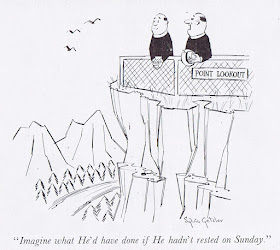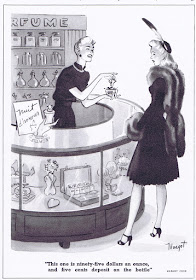The contributions of female magazine cartoonists has gone unrecognized generally. This is beginning to change. I'm thinking of Liza Donnelly's Funny Ladies at The New Yorker show at the Society of Illustrators and the Tell Me a Story Where the Bad Girl Wins: The Life and Art of Barbara Shermund
gallery show that ended in 2019, as well as the Ladies First: A Century of Women’s Innovations in Comics and Cartoon Art exhibit at the Billy Ireland Cartoon Library and Museum last year. Dick Buchanan adds to the knowledge and awareness with today's well-researched contribution. Thanks so much, and take it away, Dick.
---
WOMEN GAG CARTOONISTS
(1940-1957)
While there were several women cartoonists in the first part of the 20th century, by the end of WWII women gag cartoonists were becoming a rarity. Not surprisingly, there is little biographical information on most. Undaunted, the Cartoon Clip File shares some examples of work by a few women cartoonists who somehow managed find their way in the male-dominated gag cartoon world during the mid-century, beginning with a nod to the first woman cartoonist. Take a look . . .
ROSE O’NEILL
Rose O’Neill became the first woman cartoonist to be published in an American magazine when her drawings were featured in True Magazine, September 16, 1896 . During the early 20th century she was the best-known and highest paid female commercial illustrator in the United States. O' Neill earned a fortune and international fame by creating the Kewpie, the most widely known cartoon character until Mickey Mouse came along. Her drawings appeared in Life, Cosmopolitan, Good Housekeeping and many other publications.
1. ROSE O’NEILL. In 1897 O’Neill became the one-and only woman staff member of Puck, where she remained until 1904. Puck September 6, 1899.
MURIEL JACOBS
Muriel Jacobs’ drawings appeared in many major magazines for nearly two decades. We have no information on her except that she lived and worked, as did many cartoonists, in New York’s Greenwich Village, where apartments were cheap and there were plenty of great bars.
1. MURIEL JACOBS. The Saturday Evening Post May 28, 1949.
2. MURIEL JACOBS. Collier’s October 28, 1950.
3. MURIEL JACOBS. The Saturday Evening Post June 15, 1957.
SYLVIA GETSLER
Sylvia Getsler was born in Poland and came the America in 1933. She made Wednesday “Look Day” every week, with her young daughter in tow.
1. SYLVIA GETSLER. The Saturday Evening Post May 28, 1949.
2. SYLVIA GETSLER. Collier’s October 28, 1950.
3. SYLVIA GETSLER. The Saturday Evening Post June 15, 1957.
JANE KING SPEAR
Jane King Spear, born in LaGrange, IL, lived and worked in New York City. Her gag cartoon work helped support her career as a painter.
1. JANE KING SPEAR. Collier’s November 24, 1951.
2. JANE KING SPEAR. Collier’s March 29, 1952.
3. JANE KING SPEAR. Collier’s July 18, 1953.
MERRYLENN
Merrylenn Townsend’s cartoons appeared in many leading magazines including Collier’s and The Saturday Evening Post.
1. MERRYLENN TOWNSEND. Collier’s April 20, 1940.
2. MERRYLENN TOWNSEND. Collier’s April 3, 1943.
3. MERRYLENN TOWNSEND. American Legion Magazine November, 1946.
MARGOT
Margot Cook was born in San Diego and grew up in Texas. She studied design at Texas State College for Women. She sketched fashions for a Houston department store until she earned enough money to move to New York, where she studied at the Art Students League. Her cartoons appeared in Life, Collier’s and other national magazines during the 1930’s and early 1940’s. She was married to cartoonist and illustrator Louis Priscilla.
1. MARGOT COOK. Portrait by Louis Priscilla. Colliers March 22, 1941.
2. MARGOT COOK. Collier’s April 20, 1940.
3. MARGOT COOK. Collier’s March 22, 1941.
MARTHA BLANCHARD
Martha Blanchard was perhaps the most successful woman cartoonist of the 1950’s. She studied at the Art Students League, selling her first cartoon in 1947, becoming a regular contributor to Collier’s and The Saturday Evening Post. Her cartoons also appeared in Look Magazine, Pictorial Revue, Punch and in many women’s magazines such as Ladies’ Home Journal, American Magazine and Good Housekeeping. She illustrated several books, including “Dear Rabbi.” and Jean Kerr’s popular best-seller “Please Don't Eat the Daisies.” A collection of her cartoons, “Husbands and Lovers” was published by Dell in 1971. In her spare time Blanchard entertained residents of local veteran’s hospitals with caricatures.
1. MARTHA BLANCHARD. The Saturday Evening Post. June 14, 1947.
2. MARTHA BLANCHARD. The Saturday Evening Post March 17, 1948.
3. MARTHA BLANCHARD. American Magazine August, 1950.




















No comments:
Post a Comment